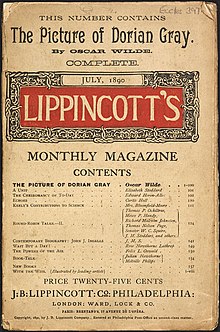
Back صورة دوريان غراي Arabic La semeya de Dorian Gray AST Delt va Dorian Gray (suterot) AVK Dorian Qreyin portreti Azerbaijani Партрэт Дарыяна Грэя BE-X-OLD Портретът на Дориан Грей Bulgarian দ্য পিকচার অফ ডোরিয়ান গ্রে Bengali/Bangla Slika Doriana Graya BS El retrat de Dorian Gray Catalan وێنەی دۆریان گرەی CKB
 The story was first published in 1890 in Lippincott's Monthly Magazine | |
| Author | Oscar Wilde |
|---|---|
| Country | United Kingdom |
| Language | English |
| Genre | Philosophical fiction, Gothic fiction, decadent literature |
| Published | 1890 Lippincott's Monthly Magazine |
| Media type | |
| OCLC | 53071567 |
| 823.8 | |
| LC Class | PR5819.A2 |
| Text | The Picture of Dorian Gray at Wikisource |
The Picture of Dorian Gray is a philosophical novel by Irish writer Oscar Wilde. A shorter novella-length version was published in the July 1890 issue of the American periodical Lippincott's Monthly Magazine.[1][2] The novel-length version was published in April 1891.
The story revolves around a portrait of Dorian Gray painted by Basil Hallward, a friend of Dorian's and an artist infatuated with Dorian's beauty. Through Basil, Dorian meets Lord Henry Wotton and is soon enthralled by the aristocrat's hedonistic worldview: that beauty and sensual fulfillment are the only things worth pursuing in life. Newly understanding that his beauty will fade, Dorian expresses the desire to sell his soul, to ensure that the picture, rather than he, will age and fade. The wish is granted, and Dorian pursues a libertine life of varied amoral experiences while staying young and beautiful; all the while, his portrait ages and visually records every one of Dorian's sins.[3]
Wilde's only novel, it was subject to much controversy and criticism in its time but has come to be recognized as a classic of Gothic literature.
- ^ The Picture of Dorian Gray (Penguin Classics) – Introduction
- ^ McCrum, Robert (24 March 2014). "The 100 best novels: No 27 – The Picture of Dorian Gray by Oscar Wilde (1891)". The Guardian. Retrieved 11 August 2018.
- ^ The Picture of Dorian Gray (Project Gutenberg 20-chapter version), line 3479 et seq. in plain text (Chapter VII).
© MMXXIII Rich X Search. We shall prevail. All rights reserved. Rich X Search